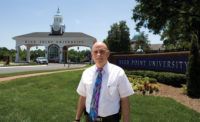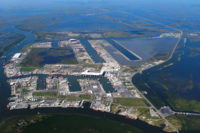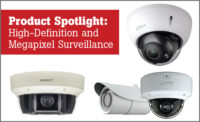Developing Low-Profile Surveillance for High-Profile Security
In the continually moving environment of a casino, adding covert surveillance tools proves an unobtrusive way to get unobstructed images.

The Hard Rock Casino and Hotel in Tulsa, Oklahoma, also includes bars, restaurants and a music venue, “The Joint: Tulsa.” Covert surveillance, including pinhole cameras in fixtures or signage and discreet camera placements, helps security personnel and law enforcement to positively identify suspicious characters on the property. Photos courtesy of the Hard Rock Casino & Hotel
It’s not Spy vs. Spy; it’s good security.
Despite the installation on numerous ceiling-mounted surveillance cameras, important details can still be missed. If a person is wearing a ball cap, or looking down at his phone, ceiling-height cameras might be unable to provide the positive identification needed for investigations.
According to John Underwood, Manager of Surveillance Technology for Cherokee Nation Entertainment, which includes the Hard Rock Hotel and Casino in Tulsa, Oklahoma among their 10 casino properties, the goal is to get the right surveillance coverage without disturbing visitors’ experience. In this, he turned to more covert surveillance tools.
“For a long time, this was taboo with operational management in the environment we’re in – casino and gaming. Cameras can be seen as a necessary evil – those black domes hanging on the ceiling – and you start talking about bringing cameras down to eye level, you start having issues about getting the most cooperation, and that’s understandable,” Underwood says. “We’re trying to make sure we do this in the most seemly fashion, not being a distraction, hanging black dome cameras on the wall to look like a black eye on the design of the building. We wanted to do this in a way that won’t disturb anyone or take away from the experience being marketed, but we can do our due diligence in gathering all the information possible, whether that’s for data mining with analytics or for video investigations – internal loss prevention or law enforcement – I’m able to deploy more tools to be more effective.”
There are three main areas of focus for covert surveillance installations around the casino, Underwood says.
-
Doorframes/Entry points: Adding eye-level surveillance at these choke points for incoming and exiting traffic enable security personnel to maintain more accurate awareness of who is entering the establishment and when.
-
Cashier stations: Pinhole cameras or other discreet tools at these locations enable security personnel to verify identities to help either prevent or investigate ID, tax, or check fraud, as well as to get a better image of the visitor’s face as he or she interacts with the cashier.
-
ATMs: While ATMs often have covert cameras installed, many are only activated during a transaction, both for efficient searching and to save on storage. However, for Underwood, many ATMs are near heavy-traffic areas in the casino, so he prefers ATM cameras activated on movement, so they provide another eye-level point of view for situational awareness, not limited to footage during the time of the transaction.
Underwood also adds more discreet surveillance tools in less-trafficked areas such as stairwells. There is an expectation of surveillance in elevators, he says, so potential bad actors duck into stairwells or other lesser used areas for illicit acts.
“Yes, by having overt surveillance in busy areas, you will deter (bad actors) to a point, but if you have something covert in (lesser-used) places, you may actually capture the incident rather than having to assume that something may have just happened, because you’re being a bit more discreet.”
Underwood was inspired by an analytics program at the Dallas Cowboys Stadium, which utilizes video analytics to determine which advertisements are most effective and eye-catching to visitors, to find items around the casino that would draw the eye and install surveillance there. He works with the marketing department for the casino to get fixtures or signage to add a discreet, covert camera so that when visitors look at the display or sign, the security team also gets a clear image of their faces.
“If we have a guy who wants to come in with sunglasses on and pass a counterfeit check… now he’s got his low-brim baseball cap on or cowboy hat, and I’m now no longer obstructed by those,” says Underwood. “I’ve been able to provide to law enforcement agencies or those at other casinos or other companies tangible data and intelligence to help these people be caught, prosecuted or at least be able to ensure that we can work on the next stage of the investigation when they arrive. There’s no longer the question mark of ‘is this the right guy or not?’ Now I’m seeing past the brim of that ball cap because I’m no longer looking from the 24-foot ceiling trying to get the right angle to see him sitting down – I’m seeing directly into his face.” Also, in working with law enforcement agencies, “we’ve become the go-to for any type of video intelligence,” Underwood adds.
With so many cameras in play, however, challenges do arise. Underwood and his internal team test potential cameras and tools against a number of parameters and situations. Devices that they do adopt and use must:
-
Be non-intrusive;
-
Provide a proper image, despite interference from continuous motion and lights from slot machines, bar venues and employees, and smoke; and
-
Offer options to ease storage burdens, such as H.264 or H.265 compression standards, Zipstream technology, lowering frame rates or being able to turn off or avoid certain high-storage features, such as wide dynamic range.
“With covert (surveillance), I’m not always seeing incidents in most of those areas, I’m gathering information. I’m providing other tangible features of quality video or quality still shots to provide over to the investigative side and help to identify somebody,” Underwood says.
View new products for covert surveillance applications in our photo gallery here.
Looking for a reprint of this article?
From high-res PDFs to custom plaques, order your copy today!





